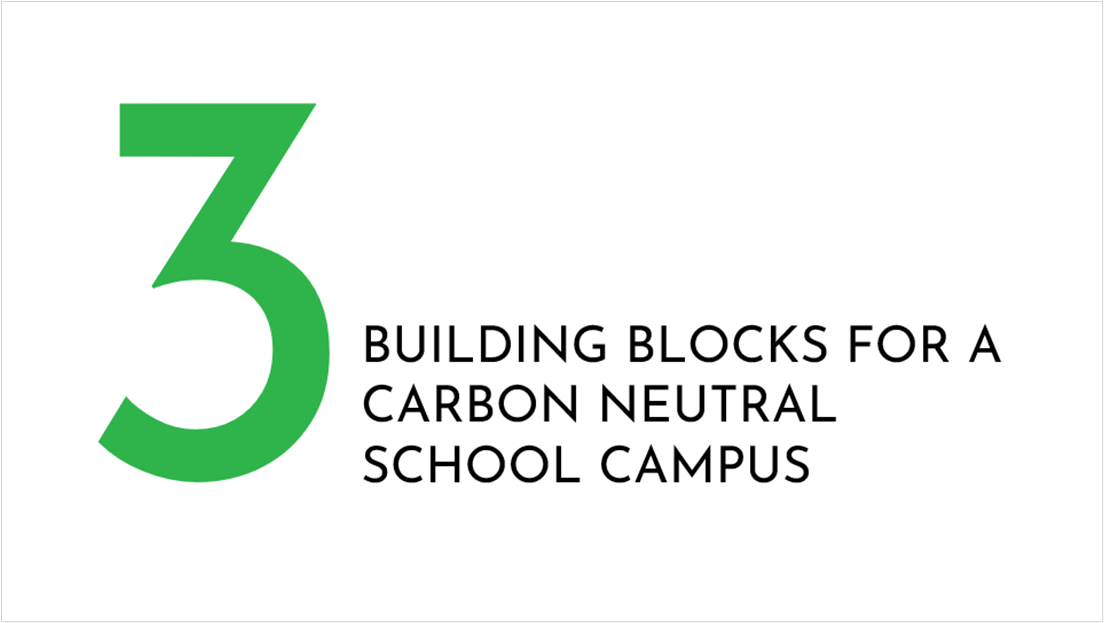
Children need to establish a deeper connect with their surroundings and nature, and what better place to initiate this than at schools, a place where the young minds of tomorrow spend a majority of their time in? Schools provide the perfect setting for students to expand their ecological identity, to establish the connect with their environment to ensure that they grow up to be eco-conscious adults. Climate Education plays an irreplaceable role in the development of environmentally responsible future generations, as seen in our earlier blogpost.
Schools act as the perfect systems to involve and influence children, along with their parents and teachers, plus any of the others who may have contact with these students through activities like mentorship. Schools have paramount scope to change the way students perceive Sustainability and a very significant role to play to encourage the proper, sustainable use of natural resources. School can imbibe Sustainability in real time in 3 broad areas.

1. Sustainable Infrastructure
This includes the school buildings and school campuses. In the context of carbon emissions, there are 2 broad categories that are relevant for schools – embodied carbon emissions and operational carbon emissions. The conversation on sustainable infrastructure deals with the embodied carbon emissions, which essentially refers to all the carbon footprint that gets embedded in the way the campus has been built. From the material that went into the construction of the buildings to the way the school has considered natural ventilation over artificial lighting and cooling, the embodied carbon emissions are significant.
For schools that are constructing new physical spaces, they have an opportunity to bring these aspects into consideration and be conscious while making the decisions. This is the ideal time to decide right to avoid embodied emissions, wherever the opportunity exists.
It is obvious that existing campuses will not be able to do much about the core construction material that has gone into building their campus. Yet, they can still address the secondary aspects that embellish the building infrastructure – energy infrastructure, cooling setup, water infrastructure etc. The principles of green buildings from recognized authorities like GRIHA for Existing Day Schools should be considered.
Schools must start opting for greener buildings, using sustainable and environmentally responsible construction material, include better and greener planning, switch over to using renewable sources of energy like Solar to produce electricity and recycle and repurpose rainwater by installing Rainwater harvesting structures on campus. These are some of the ways in which schools can implement Sustainable Infrastructure.
2. Sustainability in Operations
While the embodied emissions are factored in during the construction or installation phase, operational emissions occur all through the life of the building. Sustainability in terms of the operations of the school could include practices and policies that help in the reduction of waste and the utilization of resources like water and energy in the most efficient way possible. It could also include proper waste management, segregation, disposal and repurposing.
This is where the concept of the Green School campus takes prominence.
A ‘Green School’ is a resource-efficient school campus that very efficiently uses and manages their air, energy, water, food, land and other resources whilst minimizing waste, thereby providing a healthier environment for students to grow up in, as compared to a conventional school campus.
At the same time, a ‘Carbon Neutral School’ is one that is not only fully aware of its Carbon footprint, the amount of carbon being emitted directly on campus, indirectly via its operations, purchased energy, and travel, but also the one that is able to completely reduce or offset its carbon emissions over time. Carbon Neutral Schools set Science Based Targets & follow certain pre-ascertained protocols to manage, report and reduce their carbon footprint.
While it is challenging for schools to achieve ‘Carbon Neutral’ Status off the bat, the start to transforming their school campus into a ‘Green School Campus’, is a more realistic and quickly achievable goal. This could, in turn, help students experience sustainability personally. Schools should consider regular checkpoints during operations to ensure that they remain sustainable in the long run. They should consider a frequent audit exercise, like the one managed by the Green Schools Program by CSE.
3. Sustainability Education
This is not only directed towards the students but also for every other individual involved in the school system: be it parents, teachers or other members of the school staff. It is crucial that this information and education is imparted in an understandable and earnest way, emphasizing “WHY” these actions need to be followed, these changes need to be made and how it will help impact the school environment, the students and even the planet in a positive manner. This will ensure that the people involved will be more likely to stick to any changes being implemented.
When imparted to the students, this information should be made as interactive, light and fun as possible while being factual and honest. It should complement the existing syllabus to make it easily understandable. This additionally makes teachers better equipped and the students more involved and helps kindle their interest whilst making them more responsible, building a sense of leadership and ensuring that tomorrow’s changemakers are on the right track.
Combined with the conventional learning which can be obtained through a traditional school education, this helps students develop holistically and garner 21st century skills, as proposed by the NEP (National Educational Policy 2020) - in India.
Schools have the opportunity to transform their campuses into ‘Living Labs’ of Sustainability. They could show students, first-hand, what it would look like if an entire environment is made completely sustainable and eco-friendly. Schools can reimagine their premises as playgrounds that provide students with the tools and setting to propagate ideas, develop and hone new essential skills, and practice sustainability.
